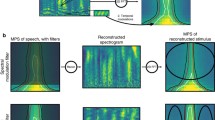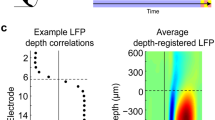Abstract
Receptive field properties of neurons in A1 can rapidly adapt their shapes during task performance in accord with specific task demands and salient sensory cues (Fritz et al., Hearing Research, 206:159–176, 2005a, Nature Neuroscience, 6: 1216–1223, 2003). Such modulatory changes selectively enhance overall cortical responsiveness to target (foreground) sounds and thus increase the likelihood of detection against the background of reference sounds. In this study, we develop a mathematical model to describe how enhancing discrimination between two arbitrary classes of sounds can lead to the observed receptive field changes in a variety of spectral and temporal discrimination tasks. Cortical receptive fields are modeled as filters that change their spectro-temporal tuning properties so as to respond best to the discriminatory acoustic features between foreground and background stimuli. We also illustrate how biologically plausible constraints on the spectro-temporal tuning of the receptive fields can be used to optimize the plasticity. Results of the model simulations are compared to published data from a variety of experimental paradigms.






Similar content being viewed by others
References
Aertsen, A. M., Olders, J. H., & Johannesma, P. I. (1981). Spectro-temporal receptive fields of auditory neurons in the grassfrog. III. Analysis of the stimulus-event relation for natural stimuli. Biological Cybernetics, 39, 195–209.
Arfken, G. (1985). Lagrange multipliers. In: Mathematical methods for physicists (pp. 945–950). Orlando: Academic.
Atiani, S., Elhilali, M., David, S. V., Fritz, J. B., Shamma, S. A. (2009). Task difficulty and performance induce diverse adaptive patterns in gain and shape of primary auditory cortical receptive fields. Neuron, 61(3), 467–480.
DeAngelis, G. C., Ohzawa, I., & Freeman, R. D. (1995). Receptive-field dynamics in the central visual pathways. Trends in Neurosciences, 18, 451–458.
Fisher, W. M., Doddingtion, G. R., & Goudie-Marshall, K. M. (1986). The DARPA speech recognition research database: Specifications and status. Proc. DARPA Workshop on Speech Recognition, February 1986, pp. 93–99.
Fritz, J. B. (2005). Do Salient Temporal Cues Play a Role in Dynamic Receptive Field Plasticity in A1? In: Association for Research in otolaryngology Abstract 1323.
Fritz, J., Elhilali, M., & Shamma, S. (2005a). Active listening: task-dependent plasticity of spectrotemporal receptive fields in primary auditory cortex. Hearing Research, 206, 159–176.
Fritz, J. B., Elhilali, M., & Shamma, S. A. (2005b). Differential dynamic plasticity of A1 receptive fields during multiple spectral tasks. Journal of Neurophysiology, 25, 7623–7635.
Fritz, J. B., Elhilali, M., & Shamma, S. A. (2007). Adaptive changes in cortical receptive fields induced by attention to complex sounds. Journal of Neurophysiology, 98, 2337–2346.
Fritz, J., Shamma, S., Elhilali, M., & Klein, D. (2003). Rapid task-related plasticity of spectrotemporal receptive fields in primary auditory cortex. Nature Neuroscience, 6, 1216–1223.
Heffner, H. E., & Heffner, R. S. (1995). Conditioned Avoidance. In G. M. Klump RJ Dooling, R. R. Fay & W. C. Stebbins (Eds.), Methods in comparative psychoacoustics (pp. 79–94). Switzerland: Birkhauser Verlag.
Klein, D. J., Depireux, D. A., Simon, J. Z., & Shamma, S. A. (2000). Robust spectrotemporal reverse correlation for the auditory system: optimizing stimulus design. Journal of Computational Neuroscience, 9, 85–111.
Kowalski, N., Depireux, D. A., & Shamma, S. A. (1996). Analysis of dynamic spectra in ferret primary auditory cortex. I. Characteristics of single-unit responses to moving ripple spectra. Journal of Neurophysiology, 76, 3503–3523.
Ladefoged, P. (2005) A course in phonetics. Wadsworth Publishing; 5 edition (June 24, 2005).
Moler, C. B., & Stewart, G. W. (1973). An algorithm for generalized matrix eigenvalue problems. SIAM Journal on Numerical Analysis, 10, 241–256.
Soto, G., Kopell, N., & Sen, K. (2006). Network architecture, receptive fields, and neuromodulation: computational and functional implications of cholinergic modulation in primary auditory cortex. Journal of Neurophysiology, 96, 2972–2983.
Theunissen, F. E., David, S. V., Singh, N. C., Hsu, A., Vinje, W. E., & Gallant, J. L. (2001). Estimating spatio-temporal receptive fields of auditory and visual neurons from their responses to natural stimuli. Network, 12, 289–316.
Yin, P, Fritz, J. B., Shamma, S. A. (2007). Can ferrets perceive relative pitch? In: Association for research in otolaryngology. Denver: Abstract 843.
Acknowledgement
This work was supported by the National Institutes of Health (grants R01DC005779 and F32DC008453).
Author information
Authors and Affiliations
Corresponding author
Additional information
Action Editor: J. Rinzel
Appendix I
Appendix I
Derivation of Eq. (1)
Expanding the first term:
Where H and C 1 are defined as:
But the Eq. (5) is a quadratic form itself:
Expanding the other two terms of Eq. (4) in the same way, d can be written as:
Rights and permissions
About this article
Cite this article
Mesgarani, N., Fritz, J. & Shamma, S. A computational model of rapid task-related plasticity of auditory cortical receptive fields. J Comput Neurosci 28, 19–27 (2010). https://doi.org/10.1007/s10827-009-0181-3
Received:
Revised:
Accepted:
Published:
Issue Date:
DOI: https://doi.org/10.1007/s10827-009-0181-3




